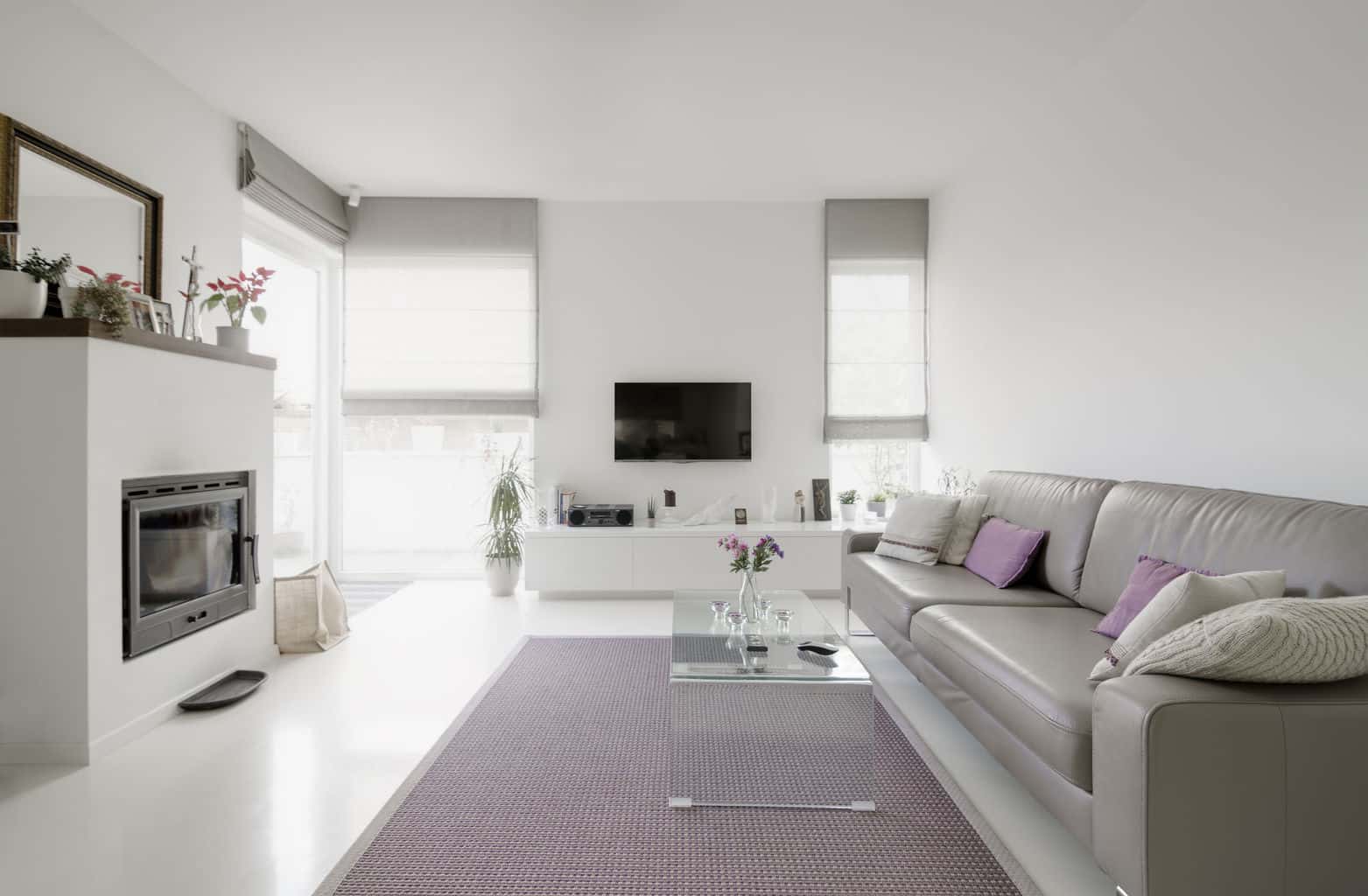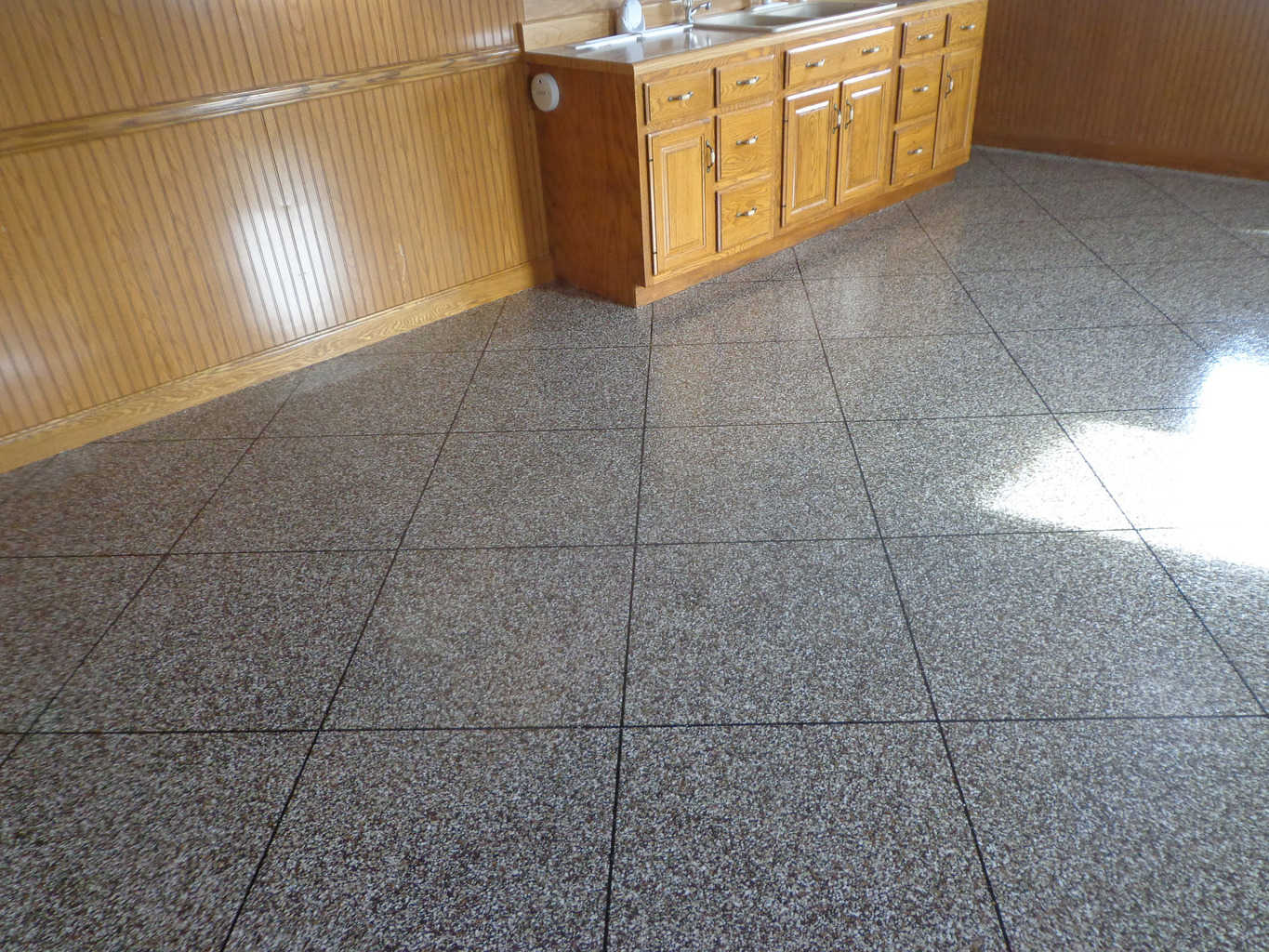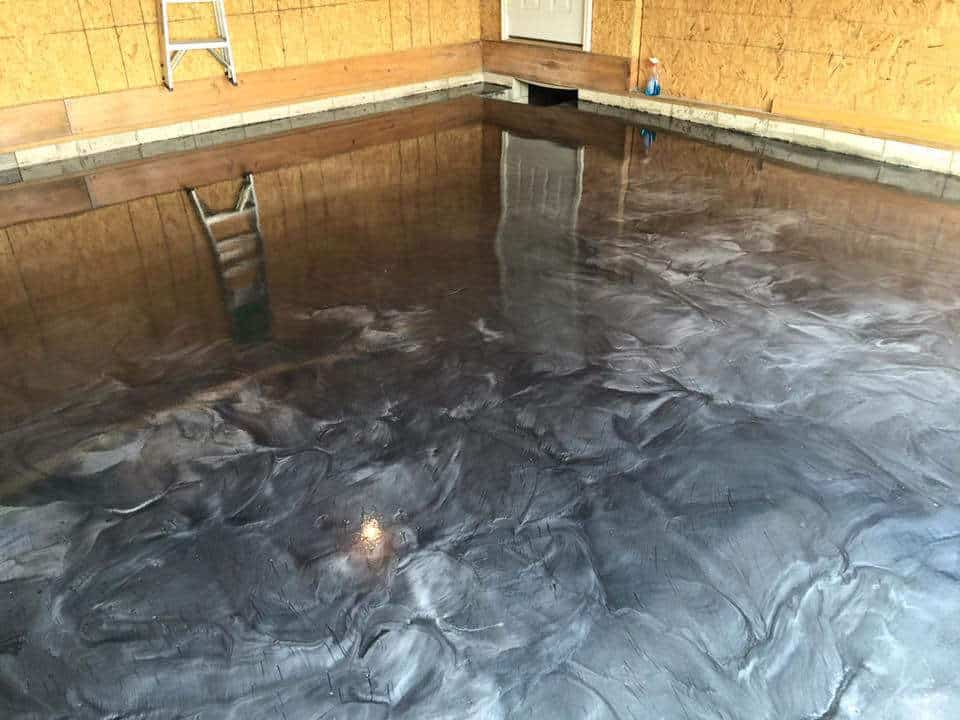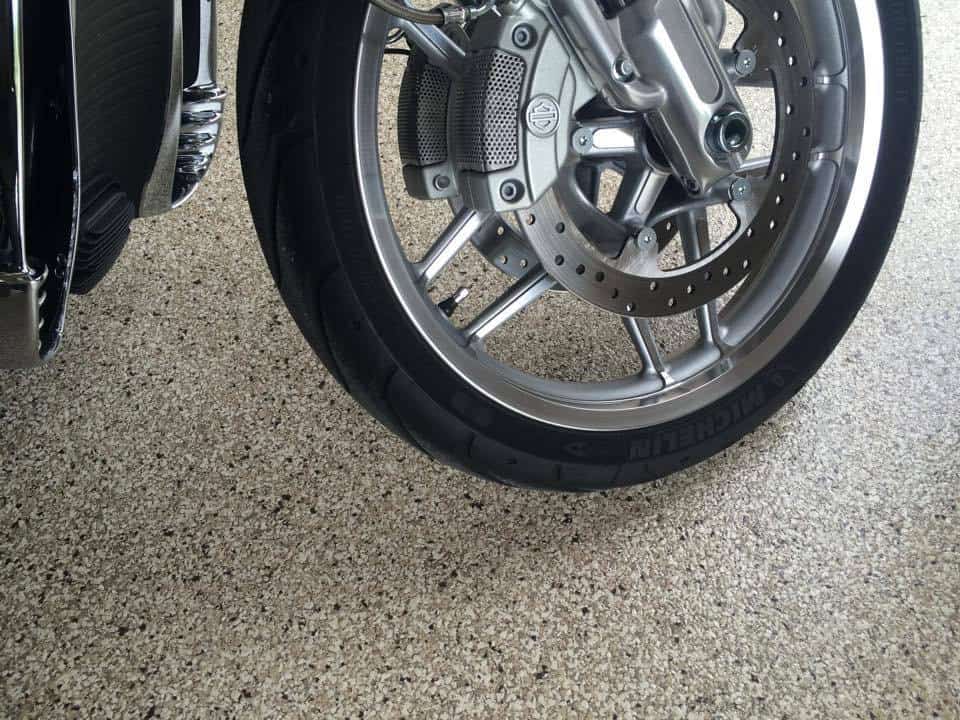Epoxy flooring, also known as epoxy resin flooring, has industrial and home applications. It can be used to protect flooring, or fix flawed flooring, in warehouses, shipping and receiving, or showrooms.
This flooring choice is common in industrial or commercial locations, but is often overlooked or never even considered for home use.
However, the final finish of epoxy is seamless and has a shine to it that really increases the high-end look of the room.
As the industrial style is more often brought into homes and luxury apartments, epoxy flooring starts to gain a specific appeal.
Add to this luxury aesthetic the ease of cleaning and maintaining these floors, and you may want to consider epoxy flooring. Imagine how great an epoxy stone, aggregate, or pebble flooring would be in your entry, laundry, or even kitchen to provide a durable that looks great too.
What In the World is Epoxy Flooring?
If you have a hard concrete surface that you want to protect, then epoxy flooring can be the answer to your prayers.
Not only is it an inexpensive way to mask any flaws, but it also creates a safe and durable surface for your chosen area.
Epoxy itself was first used in aerospace facilities back in the 1950s.
With all of the advantages to this DGEB A/F Epoxy Resin, Polyoxyalkyleneamine, and silica sand blend, the uses have multiplied over into the electronics industry and flooring.
Because epoxy floor covering works well to resist water and other materials, it is most often seen as industrial/garage epoxy flooring.
Easy to keep clean and tough under pressure, this floor covering is non-flammable, which is a great advantage when working in extreme conditions.
Some manufacturers have found ways to incorporate epoxy into wood flooring as well — to ensure that fires are limited should they start.
This has found a lot of takers especially in places which are prone to accidents caused due to fire.
For instance, there has been a spike in the number of restaurants that have opted for epoxy flooring in the last decade or so.
The numbers are set to rise with it gaining more popularity.

Why Choose Epoxy Flooring?
Don’t let the idea of industry scare you off though, decorative epoxy covering is available, with the ability to create aggregate, pebble and resin flooring with the epoxy fillers.
Since it’s such a good adhesive, these mixtures perform quite well in home decorating durable and attractive.
It's arguably the best type of flooring you can use for your garage for those reasons.
If you are considering renovating your home in the near future, it would be a good idea to check out epoxy flooring as well.
Better still, you can ask your friends or relatives or do some online research to get first hand opinions from those who may have already gone for this durable, modern flooring finish.
When trying to select a flooring from the countless options available out there, it’s smart to start by weighing the pros and cons.
Every flooring has advantages and disadvantages.
The right choice for your home, your lifestyle and your room in particular is not going to be the same as for others.
Make your list of wants and needs and compare them with the following pros and cons of epoxy flooring to see if this could be the right choice for you!

Epoxy flooring has the following main advantages:
- Strong adhesive properties: This means the flooring won't peel up or chip overtime.
- Chemical and liquid resistance: Chemical spills won't damage the epoxy and this flooring can stand up to a lot of different kinds of messes, making it a fantastic choice for restaurants, gyms, kitchens, and work spaces.
- Doesn't shrink: once the epoxy has cured, it doesn't flex with changes in temperature or humidity.
- Durable: The strength of epoxy flooring is one of its greatest attributes. You can drop weights on the flooring or drive a car over it and it will not chip or crack.
- Non-flammable: Due to the non-flammable nature of epoxy, it has become a great choice for restaurants and kitchens. Some companies have even started mixing epoxy with other flooring materials to attempt to reduce the flammability of the flooring.
- Easy to use: Chemical and liquid resistance mean you can use anything to keep the floors clean and well maintained. Epoxy flooring is naturally shiny and, so, basic cleaning will keep them looking fabulous.
Disadvantages of using epoxy flooring in your home:
- The curing process requires that the area be unused for at least twelve hours (or in some cases, even longer) after application.
- Chemical compounds may cause irritant and/or allergic contact reactions.
How is Epoxy Flooring Installed and Maintained? Can I Install it Myself?
One of the greatest advantages to decorative epoxy flooring is that it is applied as you would apply paint to the floor.
The epoxy is brushed on (after a primer coat, of course) and left to dry.
The video below shows the entire process of applying a luxury epoxy coating to concrete flooring by a professional.
The initial hardness can be felt at twelve hours after application, and at twenty four hours, you’re able to feel the real strength.
Over the course of the week, the total strength and firmness will be evident. Owing to the above, in most cases, you wouldn’t need an expert to do that for you.
Most people can do this on their own if they have an understanding of floor painting and the necessary equipment.
However, if done incorrectly, the main appeal of epoxy-it’s seamless shine-can really fail. For this reason, I strongly recommend you hire a contractor who is familiar and experienced with epoxy flooring installation.
Regardless of who does the install, it is strictly advised that the floor is not used before at least 24 hours for best results.
But waiting for this length of time results in the aspect of epoxy most find attractive: for the day of sacrifice, you get a surface that can handle truck traffic and chemical spills.
And in the industrial arena, these are well worth any initial investment.
While this finish is strong and durable, it is not infallible. Epoxy can be scratched and may yellow over time, especially in an area exposed to a lot of sunlight.
The seamless look makes it more difficult to make small repairs and damage is not easy to hide.
Now, For Some Technical Specifications
And here are some technical facts about epoxy finish: the bond strength (ASTM C-882) is 2110 p.s.i., which is much stronger than any other floor covering. Its flexural strength, or ability to move without breaking, (ASTM C-580-68) is 6,075 seven days after application.
The compressive strength (ASTM D-695) is 9,910 p.s.i. — extraordinarily high, and though it shouldn’t be a shock, the hardness, Shore D, is 65 in the 24 hours after application and goes up to 75 in the 7 days after applying.
Even if you don’t know what all these numbers mean, you should be able to understand that epoxy is well worth the time that you can’t walk on it.
Most traffic needs to be curtailed for at least twelve hours after application.
The longer you wait the better. Scheduling the epoxy flooring for a holiday or a Sunday is definitely the better choice owing to the low traffic or footfall.

Where Would You Put Epoxy Flooring?
- High ended gym
- Industrial style, modern looking basement
- Professional garage/ workspace
I shy away from recommending epoxy flooring in kitchens or other main areas of the home.
Because the curing process takes place in the location where the epoxy is applied (as opposed to any kind of prefabricated flooring which is cured in a strictly controlled environment), there are many factors which are difficult to control and can have a negative effect on the final flooring.
Temperatures, humidity levels and even insects can impact the final product.
For this reason, limiting the locations for this flooring to areas that are easier to control is the best way to ensure you’ll be pleased with the final result.

I am also not convinced that outdoor applications are the best place for epoxy, as any flaws will be easier to see in the sunlight and yellowing will happen more quickly.
I really see epoxy flooring as the right choice if you are more than just a hobbyist. If your gym is where you spend a lot of your time, if it’s a part of your life, a room you care about, and somewhere you want to be not just functional but truly a conversation piece, epoxy flooring is the right choice.
Similarly, if your basement or garage is your sanctuary and you want to elevate the beauty so that the room feels like a high end luxury showroom, epoxy flooring is going to be a smart decision for you.
If you have an area that needs to stay tough, like a garage, driveway, or carport, seamless epoxy flooring is one great way to go. It is also finding increased application in gyms and other places that witness regular physical activity.
For durability, attractiveness, and ease of application, decorative epoxy flooring is a very interesting option.


Hi Harry, it would probably be a good idea to patch up any rough spots in the concrete and allow those repairs to dry adequately before applying the paint. I don’t see any need for applying a sealer first and I don’t have any particular brand to recommend.
I want to replace my porcelain tile floor with white resin epoxy. The room has lots of light and windows, can you confirm if the color will fade to yellow over time. Will I have a complete finish look of one big slab of glass?
thanks!
Christina,
If considering a white resin floor a polyurethane resin that is totally UV stable would be required to prevent yellowing. I also suggest you contact a professional who is familiar with the installation of such a floor as it can be a wonderful addition to a home but if installed improperly can lead to several headaches down the road.
Flooring Queen…
I am purchasing a home that has expoxy pebble tech flooring throughout the living areas of the home. We would like to put hardwood flooring in the living/dining area. Would I have to float concrete or some sort of subsurface material over the pebble tech or can I install the hardwood right over the pebble tech??? Not laminate or engineered…but actual hardwood plank flooring.
Thanks!
Jeff,
That would depend on if you want to retain the epoxy pebble tech flooring for future use.
I would contact a local professional and or the manufacturer to determine the installation needs of your wood flooring.
What is the difference in epoxy chatahoochee and epoxy pebble stone? And where can I find it in Northern California?
Thanks,
Leona
Leona,
They seem to be the same and their names are different based on region.
I would suggest looking for concrete installers or local professional in your area who specializes in epoxy flooring. They would be your best resource to find the flooring you are looking for!
We have a kitchen floor done in Armstrong Impact in 1998. The surface is still good, but the image is worn off under the table and in front of the sink and refrigerator. Is it possible and realistic to put a epoxy floor over the laminate??
What type would you recommend.
Phil,
From what I’ve read and understand, no, you can not put an epoxy floor over laminate. To install you would have to prep the surface, normally concrete. There is also the base coat, color coat, texture, and clear top coat. There are many colors vailable as well as textures! The standard finishes are smooth, glossy, and totally seamless. It looks great, and is very clean and modern!
Hello, I was wondering if epoxy can be put over sub wood flooring. Would it be the same kind you use in a garage?
Marilyn,
No, epoxy should be applied to clean,debris free concrete that has a moisture content below 4%. Yes, it is the same type of epoxy flooring used to cover garage floors.
We just purchased a home that has 1000sq ft of pebble tech flooring and we want to put down tile instead….Do we leave the pebble tech and install over or do we have to remove it and how is the best way to do that?
Ty,
That would depend on if you want to retain the epoxy pebble tech flooring for future use. Floor height is another consideration. It will surely be easier to leave it than rip it up. I assume the pebble is in good shape.
I would contact a local professional and or the manufacturer to determine the installation needs of your tile flooring.
I have heard others say they put Expoxy over subfloor without issue. You say this cannot be done. I do not understand why not. You;d think it would adhere to subfloor better than concrete being more pourous especially when clean and dry.
Jeff,
I don’t know that I would agree that concrete is more porous than wood. I think there are a lot of different factors there that could vary.
If the joists are too far apart and/or the plywood is thin, floor flexing could cause any flooring surface installed on top to have problems. Where this would not occur with concrete.
I would read through this thread and see what others are saying.
I have exposed aggregate decking in my backyard around my pool. It has large aggregate rock that is very hard on the feet. I am looking at some kind of epoxy coating or epoxy aggregate that can be installed over this that is inexpensive to cover a large area. Any ideas? What kind of epoxy is used with the aggregate?
Aaron,
Hi. I do not have experience with this process. Normally exposed aggregate is created with concrete, and the top is left exposed by wetting the top of the concrete before it is completely dry.
I would suggest calling a local concrete mason, and asking what type of epoxy would work well to cover the top of this, or if there is better solution.
Our garage has a lot of ugly oil stains. I’ve been spending more time in the garage since I started to work on some DIY projects, and really don’t like how dirty and ugly our concrete floor is. Epoxy seems like a great idea to make the garage more pleasant and comfortable to work in. I had no idea that Epoxy goes back to the 1950s and that it was so easy to clean and so forth.
Hi Leviticus,
You are definitely right that using an epoxy on your garage floor is going to make it a much more pleasant place to be and work!
Sometimes, the areas of our homes where we spend the most time are some of the most neglected. I’m a strong believer that making your surroundings pleasant and functional, especially in the rooms where we spend the most time, is important for one’s mental well-being! This includes the laundry room, basements, and in your case, your garage!
Definitely try an epoxy if you’re seeing a lot of oil stains, as that will make those types of spills much easier to clean up.
However, remember that even on epoxy, leaving the oil on can cause discoloration and staining, so don’t just let the oil sit. Not to mention oil spills on epoxy flooring will be slippery, so exercise caution!
I have laminate wood flooring on an open floor plan living room dining room hall and kitchen and i would like poured epoxy over entire are is the okay to do? if so what type of epoxy do you recommend?
Hi Mechelle,
I would not recommend epoxy over laminate. The epoxy would not be able to soak in to the laminate well and would bubble and peel. What types of issues are you having with the laminate currently? Maybe I can help troubleshoot a different solution for you.
If you want an epoxy flooring, you could sand down the laminate completely to the porous wood underneath so that the epoxy has something to adhere to. You could also potentially try laying plywood on top of the laminate flooring if removing it is an issue, but I would say pulling up the laminate to get down to a subfloor would be your best bet!
Good luck!
Hi I love your webpage and all the great information you have but I have one question if you would please help I have it OCB flooring in my kitchen and I was wanting to do an epoxy coating on it do you know if I have to seal it first if so what is a good one and what is a good product to seal the cracks the joints I was looking at self levelers but most of the mix with water and I don’t believe I would want to put water on plywood before I put the epoxy I’d appreciate any help you could give me thank you Lisa